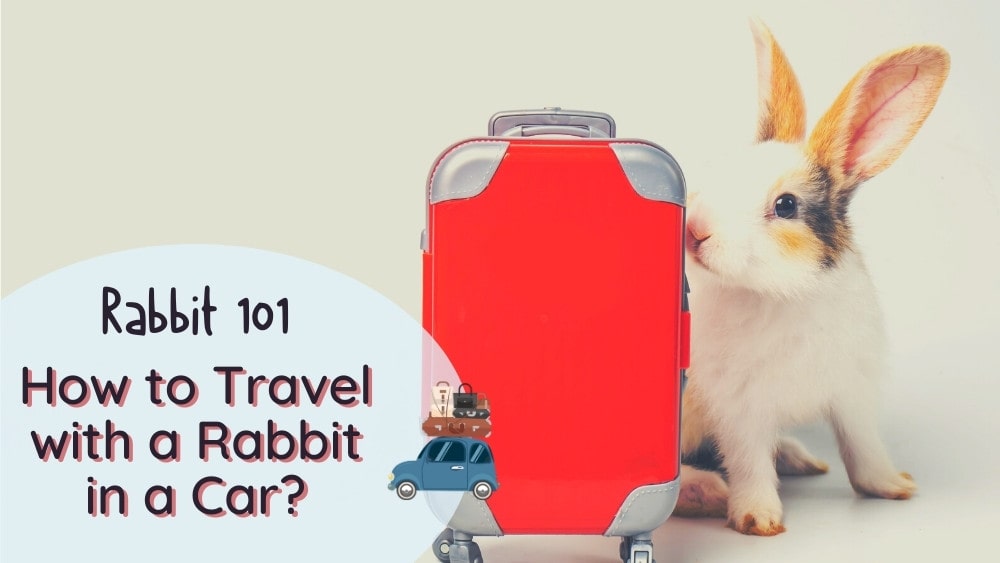Are you planning a trip with your bunny by your side? Whether you’re hitting the road or taking to the skies, your rabbit may be able to travel with you – as long as you plan carefully.
The stress and irregular eating patterns that come with travel can be dangerous for rabbits, and bunnies can quickly overheat in a car. So this article will walk you through all you need to consider to have a smooth and comfortable journey, including:
- Whether you should travel with rabbits.
- A safe transport cage.
- A packing list of supplies.
- Where to place the carrier in the car.
- Warning signs to watch for.
- How to take travel breaks with a bunny.
How to Travel With a Rabbit
- Research and purchase the best rabbit travel carrier.
- Get your rabbit accustomed to the carrier.
- Prepare everyday and emergency supplies to bring.
- Position the rabbit in the best place in the car.
- Take a 1-2 hour break for every 8 hours of travel.
- Watch for signs of distress.
- Keep your rabbit comfortable overnight.
Should You Bring Your Rabbit on Vacation?
While the White Rabbit from Alice’s Adventures in Wonderland led the charge through strange and mysterious lands, most real-life rabbits are not so adventurous.
Long-distance travel is completely foreign to a rabbit’s natural way of life. Rabbits in the wild have a territory that spans only about 6 acres. They never climb to significant heights and never travel faster than they can run. And they only run their fastest when they’re running for their lives.
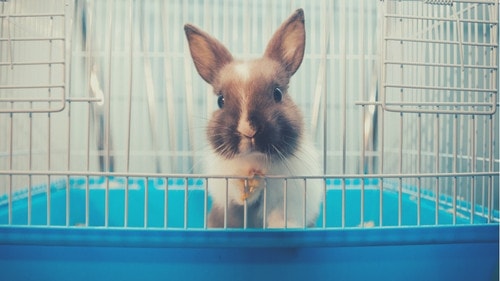
So flying through space at 60 miles an hour in a large and noisy machine, only to arrive at a new place with unrecognizable sights, sounds, and smells, is a terrifying experience for most rabbits.
Some rabbits are better travelers than others. I’ve had a couple of bunnies that were unfazed by car trips and the arrival destinations.
But, in general, bringing rabbits with you on vacation is unrealistic and stressful. Investing in the equipment to do it safely and comfortably is also expensive.
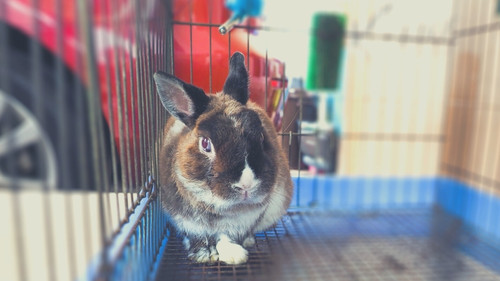
In most cases, leaving your bunny with a caretaker or pet sitter is a better option for your rabbit.
How to Plan a Trip With a Rabbit
There may be times – like when moving cross-country – that you cannot avoid bringing your rabbit on a long car trip. In these situations, preparation is crucial for protecting your rabbit from the stress of travel.
Step 1 – Choose a Travel Carrier
Many of us brought our first rabbits home in a cardboard box, but that’s hardly a suitable transport carrier.
Good transport carriers for rabbits can be wire, plastic, or made of soft cloth. There are pros and cons to each.
Wire Transport Carriers
Show rabbit exhibitors, who travel with their rabbits frequently, usually use wire transport carriers. Wire carriers are easy to clean and keep the rabbit off its droppings at all times. Because they have a litter tray that you can fill with shavings, they reduce odors and the risk of bunny pee reaching the floor of your car. They are also secure; there is no way a rabbit can escape from a closed wire carrier.

However, wire carriers have one major risk: your rabbit’s feet can catch in the wire. If this happens during an accident, your rabbit’s foot could break.
Plastic Transport Carriers
Hard plastic transport carriers are suitable for carrying rabbits if you make a few modifications.
Look for a carrier with a wire door and good ventilation. The floor of a plastic transport carrier is too slippery for rabbits, so you will need to place a towel on the floor so the rabbit can rest on a safe surface.

Your rabbit may chew on the towel during transport and urinate on it. But it’s better to change the towel than to have a rabbit sliding across the carrier every time you brake.
Plastic carriers are secure, with little chance of a rabbit escaping. The semi-solid sides simulate a hole or a den, which is calming to bunnies.
Cloth Transport Bags
There are a few cloth transport carriers that are suitable for rabbits, depending on the length of the car ride that you’re taking.

Cloth transport carriers are best for short car trips. Rabbits are usually too frightened to gnaw, eat, or go to the bathroom during a car ride. But if a bunny does decide to do any of those things, cloth carriers don’t fare well. There’s also no good place to attach a water bottle on a cloth carrier.
And unless cloth or polyester transport bags have mesh sides for ventilation, rabbits carried in them can quickly overheat.

Polyester or cloth transport carriers are never suitable overnight housing for your rabbit.
Safety Ratings for Rabbit Carriers
Most pet carriers on the market have not been crash-tested or proven safe in case of an accident. However, a few are tested, approved, and certified by the Center for Pet Safety.
One of these carriers is the SleepyPod Mobile Pet Bed. The SleepyPod Pet Bed stands out as a comfortable, well-ventilated carrier for bunnies that can be buckled securely onto the car seat without the risk of crushing the animal inside. However, this is a polyester fabric carrier, so it’s better for short jaunts than for 8-hour road trips.

Features to Look For in a Rabbit Carrier
- Top-loading. A top-opening door makes it much easier to remove a rabbit without frightening it.
- Ventilation. Overheating is a huge risk to rabbits traveling in a car.
- Visibility. You need to be able to observe your rabbit while it is traveling and watch it for signs of illness.
- Sturdy. The carrier should protect the rabbit from impact, as well as things falling on it.
- Chew-proof. Rabbits can gnaw through hard plastic if given enough time, but it’s unlikely that they’ll do it when the car is moving.
- Sense of Security. Rabbits feel safest in a dark, enclosed area with secure footing. You can cover a section of the cage with a dark cloth while leaving the rest open for ventilation.
- Ease of Cleaning. From hay to droppings and spilled water, rabbits do make a mess.
How Big Should a Rabbit Carrier Be?
A rabbit carrier should be long enough for your rabbit to lie down comfortably. Some bunnies – the smart ones! – prefer to take the bumps of the road lying down rather than standing rigidly.
However, a transport carrier should not be so large that a rabbit feels insecure or could slide a long way across the cage in case of a sudden stop. Rabbits won’t use the time in the car to exercise for fun. If your rabbit dashes in terrorized circles around its transport carrier, your bunny may do better with a smaller cage.
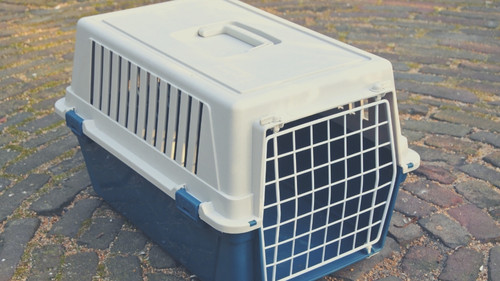
Pack along an exercise pen so your rabbit can stretch its legs once you arrive at your destination.
Step 2 – Prepare Your Rabbit for Travel
Before a long journey, some people recommend taking short practice trips with your rabbit to help your bunny get used to the car.
From what I’ve seen, most rabbits dislike car trips no matter how often they experience them. Going on “practice trips” may stress a rabbit more than necessary.
However, getting a rabbit used to spending time in the carrier can be helpful so it recognizes it as part of its normal environment.
Place the carrier on the floor during playtime with the door open. Place your bunny’s favorite treat or toy in the transport cage so it smells familiar.
Experiment at home to see if your rabbit enjoys music or white noise. If your bunny has a favorite jam, you can play this in the car to make it feel more like home. If your rabbit isn’t used to hearing music, hearing it in the car will probably scare it even more.
Step 3 – Pack For the Trip
What do I need to travel with a rabbit?
If you are bringing your rabbit on a short car ride, like to the vet’s office, you won’t have to bring many supplies. Give your rabbit a handful of vegetables and a water bottle, and bring him along.
But if you are going somewhere overnight with your bunny, here is a packing list of supplies to bring:
- Rabbit transport carrier.
- 8 oz travel water bottle
- Food dish that attaches to the cage
- 2 liters of the same water your rabbit drinks at home, whether tap or purified water.
- Hay and/or hay cubes. (Hay cubes are less messy for the car.)
- Pellets.
- Fresh vegetables and treats.
- Litter box and bedding for your overnight stay. You may want to bring puppy pads, depending on your setup.
- Pet-safe cleaner and paper towels.
- Rubber mat to catch hay or messes in your car.
- Exercise pen.
- Thermometer to monitor the temperature of your rabbit’s environment.
- Towel or blanket to cover the carrier and block out drafts.
- Towels to place in the carrier for absorbency and security.
- Rabbit first aid kit including items like critical care formula, probiotics, wound care supplies, and medications your rabbit may be taking.
- Grooming brush if you have a long-haired breed.
- Contact information for a rabbit-savvy veterinarian at your destination.
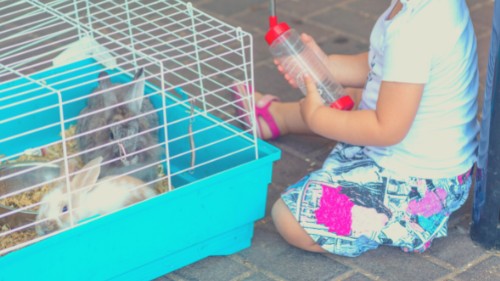
4 – Obtain Health Certificates if Necessary
If you are flying with your rabbits, you must get health certificates from a veterinarian before making the trip.
If you are driving, most states do not require health certificates. However, you can check the requirements of your destination state at the APHIS pet travel website.
If your rabbit is elderly or has other health concerns, a checkup at the vet may help you determine the risks of travel for your bunny.
Should You Sedate Rabbits for Travel?
No, sedation of small animals, including rabbits, carries more risks than the car ride itself.
Traveling with a Rabbit in the Car
All ready to go? Here are some tips to help your ride with a rabbit go as smoothly as possible.
1 – Prepare the Carrier.
Place a towel in the bottom of your plastic carrier. Fill and attach a small water bottle, and place some hay cubes and a handful of refreshing vegetables in the carrier. Treats like watermelon, carrot, or rabbit-safe herbs can provide some moisture, even if your rabbit won’t drink in the car.
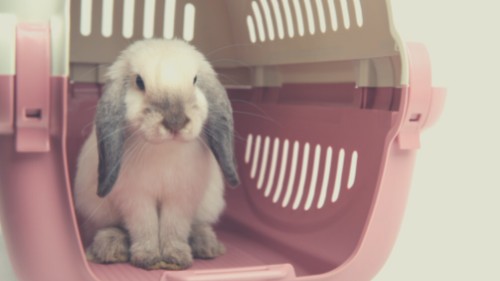
2 – Preheat or Cool the Car.
Don’t shock your rabbit by moving him from the house to the frigid car, and definitely don’t risk heat stroke by putting your bunny in a hot vehicle.
Warning! Rabbits can get heat stroke in a car in the winter! If the heat is on and blowing directly toward the rabbit, your bunny is at risk of overheating.
3 – Position the Carrier in a Safe, Comfortable Location in the Car.
Where is the safest place to put the rabbit carrier in the car? Thanks to a German auto tester ADAC, we have a research-based answer to that question. ADAC ran a series of crash tests with different pet carriers and restraint systems to determine the safest way to carry pets in a car.
The safest place for a rabbit carrier in a car is on the floor behind the vehicle’s front seats.
Rabbit Car Safety Do’s and Don’ts:
Do place the carrier on the floor of the vehicle. The ideal location is on the floor behind the front seats. However, the boot of larger vehicles is acceptable if there is good airflow.
Do position the carrier in the boot so the door is opposite the direction of travel. You don’t want your bunny to slam into the cage door, the door to open with the impact, and your rabbit to hit the side of the vehicle. And yes, this actually happened in the ADAC tests.
Do keep the carrier level at all times, using a rolled-up towel under it if necessary to keep the carrier floor level.
Don’t hold the rabbit unrestrained on your lap.
Don’t keep the carrier in the front seat, either on the seat or on a passenger’s lap. Airbags can kill a rabbit if they deploy.
Don’t use the seatbelt to secure the carrier unless you use a SleepyPod or other carrier with safety ratings. In crash tests, the seatbelts crushed the carriers that were not designed to be buckled in.
Don’t stack luggage or items on top of the rabbit carrier, or stack the carrier on anything else.
Do make sure your rabbit gets good airflow, but don’t position the vents to blow directly onto your rabbit. Keep your rabbit from drafts.
4 – Watch Your Rabbit’s Behavior in the Car
While traveling, check your rabbit often to make sure it is tolerating the stress. Don’t expect your rabbit to eat or drink much while the car is moving.
Observe your rabbit for signs of GI stasis, heat stroke, or extreme fright. These signs include:
- Very heavy panting
- Wet nose and mouth
- Lethargy
- Loud teeth grinding
- Frequent foot stomping that doesn’t subside after a few minutes.
- Throwing itself against the side of the carrier.
If your rabbit is getting panting heavily and drooling, stop immediately and move your rabbit to an air-conditioned location. Don’t hold your rabbit against your body. Instead, place a bag of ice over the cage, and moisten your rabbit’s ears so the evaporation will cool them down.
If your rabbit doesn’t resume eating, drinking, and using the bathroom once you have stopped for an hour or two, watch for signs of GI stasis.
How Do You Calm a Rabbit Down in the Car?
Keep a rabbit calm by talking in quiet voices, avoiding loud music, and giving the bunny a secure, dark corner of the carrier where it can hide.
If your rabbit doesn’t calm down after a few minutes in the car, you can play white noise or take a break so the rabbit can get out of the carrier.
5 – Take Strategic Breaks
When traveling with a rabbit, more breaks are not necessarily better. Many rabbits won’t resume eating and drinking until they’ve been out of the car for around an hour.
Taking an hour-long break every 4 hours is better than taking a 5-minute break every half hour. It’s best to get the trip over as quickly as possible.
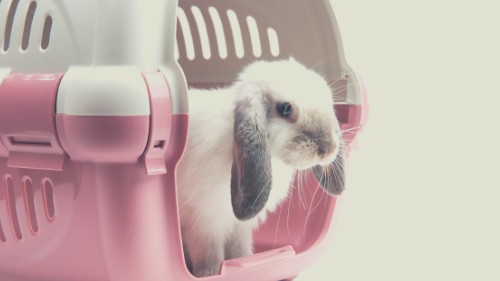
If you stop at a rest area, don’t take the rabbit out of its carrier outdoors. Each rest stop has new, frightening sights and smells for a rabbit. If your bunny is afraid and jumps out of your arms at a rest area, it may be impossible to catch.
How long can a bunny be in a car?
A rabbit can safely travel 8 hours a day in a car, as long as it has a 1 or 2-hour rest stop in the middle of the trip.
6 – Take the Rabbit Out of the Car Overnight
Never leave a rabbit in a vehicle unattended, especially not overnight.
Pack an escape-proof exercise pen and a litter box to create an overnight habitat for your rabbit similar to its enclosure at home. Add pet-safe electrolytes and probiotics to your bunny’s water to help it recover from the stress of the trip.

Airline Travel with Rabbits
Several airlines will allow rabbits to travel in cargo, and a few allow you to keep your bunny with you in the cabin. Airlines such as United, Alaska Air, and Frontier have traditionally been friendly to carrying rabbits, but regulations change frequently, so check current guidelines before booking your flight.
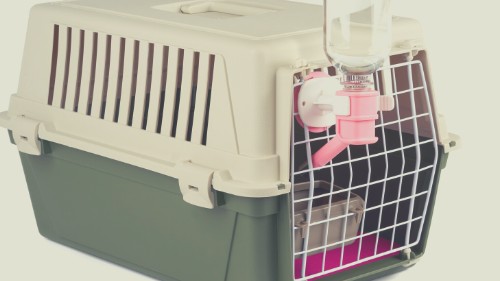
Airlines usually require a carrier with a solid top and may have other requirements, such as no open water dishes. Airlines typically require a health certificate issued by a veterinarian within 7-10 days before the flight.
Read more: Can Rabbits Travel on a Plane?
Frequently Asked Questions
Do Rabbits Enjoy Car Rides?
No. Unlike dogs, most rabbits find nothing enjoyable about car rides. However, you can take steps to make it less stressful for them, like choosing a secure carrier and playing white noise.
Is Travel Stressful for Bunnies?
Yes, travel is a very stressful experience for most rabbits, but a few take it in stride. Since you don’t know how your rabbit will react to the car’s motion, you should prepare for any outcome.
Do Rabbits get Car Sick?
Rabbits physically cannot vomit, and it’s unlikely that they suffer from motion sickness. However, make sure your rabbit has lots of high-quality hay at all times when you’re traveling to keep its digestive system moving.

Conclusion
I hope this guide helped you see travel from your bunny’s perspective, so you can prepare for the smoothest trip possible. Who knows; if you take the necessary steps to ensure your rabbit is comfortable, you may discover he has a bit of the White Rabbit’s adventurous spirit after all.
What’s the longest distance you’ve traveled with a rabbit? Let us know in the comments!


